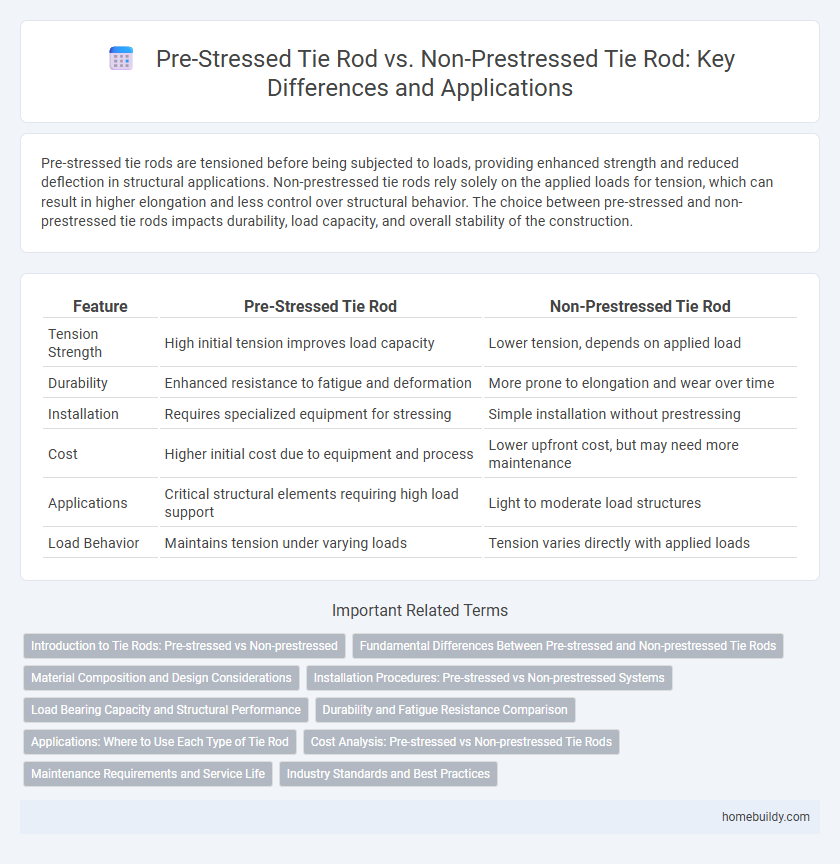Pre-stressed tie rods are tensioned before being subjected to loads, providing enhanced strength and reduced deflection in structural applications. Non-prestressed tie rods rely solely on the applied loads for tension, which can result in higher elongation and less control over structural behavior. The choice between pre-stressed and non-prestressed tie rods impacts durability, load capacity, and overall stability of the construction.
Table of Comparison
| Feature | Pre-Stressed Tie Rod | Non-Prestressed Tie Rod |
|---|---|---|
| Tension Strength | High initial tension improves load capacity | Lower tension, depends on applied load |
| Durability | Enhanced resistance to fatigue and deformation | More prone to elongation and wear over time |
| Installation | Requires specialized equipment for stressing | Simple installation without prestressing |
| Cost | Higher initial cost due to equipment and process | Lower upfront cost, but may need more maintenance |
| Applications | Critical structural elements requiring high load support | Light to moderate load structures |
| Load Behavior | Maintains tension under varying loads | Tension varies directly with applied loads |
Introduction to Tie Rods: Pre-stressed vs Non-prestressed
Tie rods, essential components in structural engineering, vary significantly between pre-stressed and non-prestressed types. Pre-stressed tie rods undergo tensioning before load application, enhancing their load-bearing capacity and reducing deflection in structures. Non-prestressed tie rods, lacking this initial tension, are more susceptible to elongation and deformation under load, impacting overall structural stability.
Fundamental Differences Between Pre-stressed and Non-prestressed Tie Rods
Pre-stressed tie rods are tensioned before being subjected to loads, enhancing their load-carrying capacity and reducing deflection under stress, while non-prestressed tie rods rely solely on the applied load for tension. Pre-stressed tie rods exhibit improved fatigue resistance and durability due to the initial compressive force counteracting tensile stresses, whereas non-prestressed rods are more susceptible to elongation and structural deformation. The fundamental difference lies in the application of pre-tension, which optimizes structural performance and longevity in critical engineering applications.
Material Composition and Design Considerations
Pre-stressed tie rods are typically made from high-strength steel alloys with a controlled carbon content and enhanced tensile properties to withstand the initial tension applied during installation. Non-prestressed tie rods often use standard carbon steel or lower-grade alloys without preloading requirements, affecting their elongation and load distribution characteristics. Design considerations for pre-stressed tie rods include accounting for stress relaxation and precise tensioning mechanisms, while non-prestressed versions emphasize simplicity and in-service load capacity without initial stress application.
Installation Procedures: Pre-stressed vs Non-prestressed Systems
Pre-stressed tie rods require tensioning during installation to apply a specified level of stress, enhancing structural performance and reducing deflection under load. Non-prestressed tie rods are installed without initial tension, relying on their inherent material strength and connections for stability. The installation of pre-stressed systems demands specialized equipment and precise monitoring to achieve exact tension values, whereas non-prestressed systems allow for simpler and faster installation processes.
Load Bearing Capacity and Structural Performance
Pre-stressed tie rods exhibit higher load bearing capacity than non-prestressed tie rods due to induced tensile stress counteracting applied loads, enhancing structural performance and reducing deflections. Non-prestressed tie rods rely solely on the material's inherent strength and are more susceptible to elongation and deformation under high loads. Pre-stressing improves fatigue resistance and durability, ensuring long-term stability in load-bearing applications such as bridges and tension structures.
Durability and Fatigue Resistance Comparison
Pre-stressed tie rods exhibit superior durability and fatigue resistance due to the initial tension that reduces stress fluctuations during load cycles, thereby minimizing the risk of crack initiation and propagation. Non-prestressed tie rods experience higher tensile stress variations, leading to accelerated material fatigue and reduced service life under cyclic loading conditions. Engineering studies indicate that pre-stressed tie rods can extend structural lifespan by up to 30% compared to their non-prestressed counterparts, particularly in dynamic or seismic applications.
Applications: Where to Use Each Type of Tie Rod
Pre-stressed tie rods are ideal for applications requiring high tensile strength and minimal elongation, such as in bridge construction, large-span roofs, and structural frameworks where load-bearing capacity and durability are critical. Non-prestressed tie rods suit lighter-duty structures like small buildings, temporary scaffolding, and machinery alignment, where flexibility and ease of installation are prioritized. Choice depends on load demands, environmental conditions, and structural stability requirements for optimal performance.
Cost Analysis: Pre-stressed vs Non-prestressed Tie Rods
Pre-stressed tie rods typically involve higher initial costs due to specialized materials and tensioning equipment but offer enhanced durability and reduced maintenance expenses over time. Non-prestressed tie rods present lower upfront investment but may incur greater long-term costs from frequent repairs and potential structural fatigue. Evaluating life-cycle costs reveals that pre-stressed tie rods provide superior economic value in projects demanding high load-bearing capacity and longevity.
Maintenance Requirements and Service Life
Pre-stressed tie rods require less frequent maintenance due to their enhanced load-bearing capacity and reduced chances of fatigue failure, significantly extending their service life compared to non-prestressed tie rods. Non-prestressed tie rods often experience more frequent inspections and adjustments to address elongation and wear, which can lead to a shorter operational lifespan. The controlled tension in pre-stressed tie rods minimizes structural deformation, optimizing durability and reducing long-term repair costs.
Industry Standards and Best Practices
Pre-stressed tie rods adhere to industry standards such as ASTM A722 and A707, ensuring high tensile strength and reduced elongation under load, which enhances structural stability in construction applications. Non-prestressed tie rods typically follow ASTM A36 or A449, suitable for less demanding tension applications where flexibility is preferred over rigidity. Best practices recommend pre-stressed tie rods for critical load-bearing structures requiring minimal deformation, while non-prestressed tie rods are suited for temporary or adjustable connections.
pre-stressed tie rod vs non-prestressed tie rod Infographic

 homebuildy.com
homebuildy.com